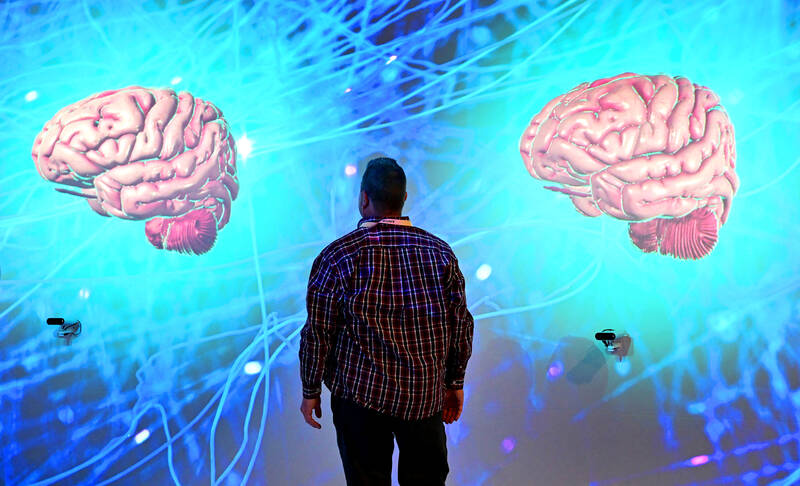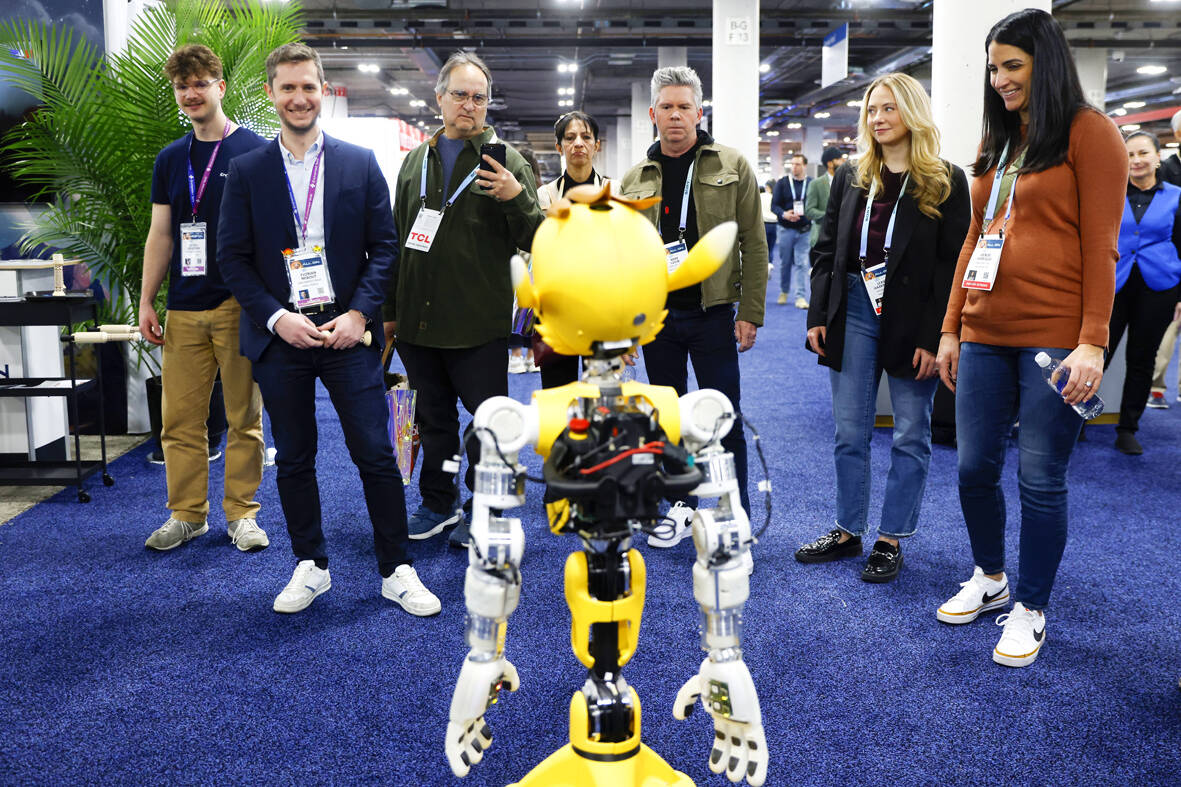With big, expressive eyes, elfin ears and adorable cooing, Miroka and Miroki could be an apparition from your favorite cartoon. But behind their cute facade, these robots are all sensors and engineering, and designed to perform the drudgery of logistical support in hospitals or hotels.
“Why live with ugly machines,” says Jerome Monceaux, head of Paris-based start-up Enchanted Tools, who was on hand to present the pair at the CES tech show in Las Vegas last week. “I could cut their heads off and erase their colors, but I’m not sure you’d want to share your daily life with them,” he continues.
A number of start-ups are working on robots that look familiar and help humans, without making them feel uncomfortable or unsafe. Amazon is currently testing Agility’s “Digit,” a two-legged android that wouldn’t look out of place in Star Wars, to carry plastic bins in its warehouses. Enchanted Tools has also bet on team-playing robots, designed to relieve staff of repetitive tasks.

Photo: AFP
But in addition to helping out, Miroki is meant to bring a touch of “wonder” to the workplace.
“It’s a way of celebrating something very beautiful in ourselves and avoid becoming machines ourselves,” said Monceaux. His company hopes to produce 100,000 robots over the next 10 years.
FILLING JOBS

Photo: EPA-EFE
Every CES brings its share of companion robots and androids, but they haven’t gained much ground in homes and businesses.
At the same time, “labor shortage has been the number one problem since COVID across different industries. Today, we have roughly 18 million job vacancies,” said Joe Lui, the global lead on robotics at Accenture.
And while some tasks have been adapted for mechanical arms and autonomous forklifts, many others require language, mobility and understanding of the environment and therefore humans.
Or humanoids infused with artificial intelligence, said Lui, who thinks AI can bring robots into everyday life.
“Humanoids are going to be really like coworkers in the coming years and natural language interfaces like ChatGPT are going to be prevalent,” said Chris Nielsen, head of Levatas, a US company that has integrated generative AI software into Spot, a quadruped robot from Boston Dynamics.
Thanks to generative AI, robots depend less on pre-written scripts.
But “don’t worry, robots like us are designed to help humans make their lives better,” robot Moxie said.
“We always follow the instructions and programs that humans give us. So you have the control.”
As tall as a teddy bear and doped with generative AI, Moxie is capable of interacting with children, telling them stories, giving math lessons and performing dance moves with two arms.
“Moxie isn’t here to replace anyone. Moxie is a mentor, tutor and a friend,” said Daniel Thorpe of Embodied, the company that created the robot.
‘FRIGHTENING’
Two-legged, mobile and autonomous humanoids still have a long way to go before they leave the laboratory. But some of their precursors have at least made it out of CES, like Moxie or Aura, a highly anthropomorphic robot that entertains patrons at The Sphere, Las Vegas’ new concert venue.
“I receive a lot of questions like how old are you, what’s the meaning of life, who’s going to win the Super Bowl?” said Aura to curious viewers.
Aura punctuates her answers with jokes, exaggerated laughter and even rolls her shoulders into a shrug. For Monceaux, highly anthropomorphic robots risk “provoking an epidermic reaction. They create confusion between our humanity and their robot nature, and are frightening. Nobody wants to have one in their home or hospital on a daily basis,” he said.
Above all, he added, “it creates an expectation of behavior similar to our own,” and therefore a risk of disappointment, because the robot doesn’t see and understand the world as we do, and won’t for years to come.”
For Jonathan Hurst, co-founder of Agility, its Digit robot would look strange without a head and creep out humans.
“We had a lot of conversation about that internally at the company” and the head was kept even if it provided no significant technical purpose.
At CES, Adam, a robot barista from Richtech Robotics, serves coffee to delighted attendees and can now make jokes, thanks to generative AI. But to refill the coffee machine with milk, he still needs humans.

Sept. 1 to Sept. 7 In 1899, Kozaburo Hirai became the first documented Japanese to wed a Taiwanese under colonial rule. The soldier was partly motivated by the government’s policy of assimilating the Taiwanese population through intermarriage. While his friends and family disapproved and even mocked him, the marriage endured. By 1930, when his story appeared in Tales of Virtuous Deeds in Taiwan, Hirai had settled in his wife’s rural Changhua hometown, farming the land and integrating into local society. Similarly, Aiko Fujii, who married into the prominent Wufeng Lin Family (霧峰林家) in 1927, quickly learned Hoklo (commonly known as Taiwanese) and

The low voter turnout for the referendum on Aug. 23 shows that many Taiwanese are apathetic about nuclear energy, but there are long-term energy stakes involved that the public needs to grasp Taiwan faces an energy trilemma: soaring AI-driven demand, pressure to cut carbon and reliance on fragile fuel imports. But the nuclear referendum on Aug. 23 showed how little this registered with voters, many of whom neither see the long game nor grasp the stakes. Volunteer referendum worker Vivian Chen (陳薇安) put it bluntly: “I’ve seen many people asking what they’re voting for when they arrive to vote. They cast their vote without even doing any research.” Imagine Taiwanese voters invited to a poker table. The bet looked simple — yes or no — yet most never showed. More than two-thirds of those

In the run-up to the referendum on re-opening Pingtung County’s Ma-anshan Nuclear Power Plant last month, the media inundated us with explainers. A favorite factoid of the international media, endlessly recycled, was that Taiwan has no energy reserves for a blockade, thus necessitating re-opening the nuclear plants. As presented by the Chinese-language CommonWealth Magazine, it runs: “According to the US Department of Commerce International Trade Administration, 97.73 percent of Taiwan’s energy is imported, and estimates are that Taiwan has only 11 days of reserves available in the event of a blockade.” This factoid is not an outright lie — that

The People’s Republic of China (PRC) yesterday paraded its military hardware in an effort to impress its own population, intimidate its enemies and rewrite history. As always, this was paced by a blizzard of articles and commentaries in the media, a reminder that Beijing’s lies must be accompanied by a bodyguard of lies. A typical example is this piece by Zheng Wang (汪錚) of Seton Hall in the Diplomat. “In Taiwan, 2025 also marks 80 years since the island’s return to China at the end of the war — a historical milestone largely omitted in official commemorations.” The reason for its